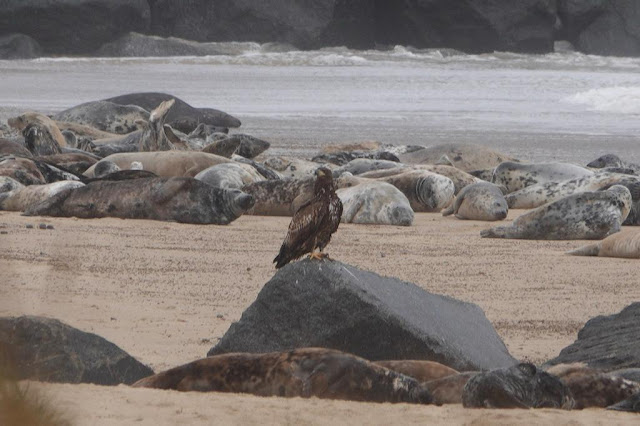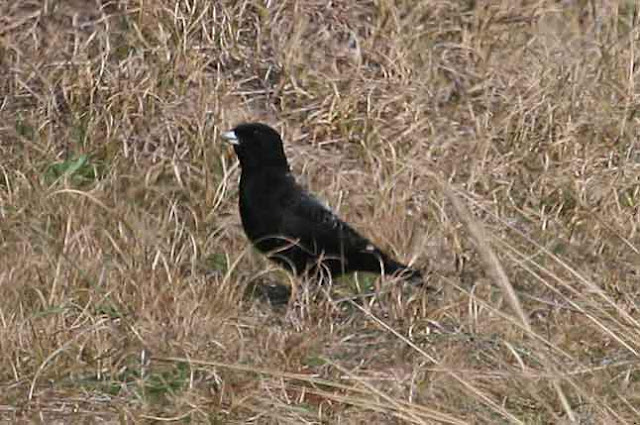Although the spring rain was notably absent, April lived up to the rest of T.S. Eliot's famous description, and migrants had a hard time of it in the almost continuous cruel and cold NE wind. The early flurry of Swallows in particular must have really struggled.
Nevertheless there were some decent birds, although it most definitely was NOT the best April ever here (which for Sean was April 2008 in case you're interested 😊 - some will remember why...). The Iceland Gull remained throughout the month, our Peregrine continued to use the church tower throughout as well, and there were pretty good numbers of Ring Ouzels to be seen, so we made do.
Mick had three Wheatears in the north dunes on the 1st, and on the Second Maynard had a Green Woodpecker, the second of the year, at the back of the Low Road paddocks. On the 3rd Pat found two more Canada Geese from the concrete track, allowing at least one of us to get a welcome grip-back for our year lists... Pat also had a Sand Martin from his garden on the same day.
Sean had a lone Swallow on the 4th, and Tim a Willow Warbler in its customary territory near to the concrete blocks. It snowed on the 5th, yet despite this Sean had the first Common Tern, along with several Sandwich Terns, an appropriate Snow Bunting and near frostbite... The tide and the wind were so powerful on the 5th that the rope fencing and posts cordoning off the hoped-for Little Tern nesting area, only erected a few days earlier, was ripped out by the sea. Mick bravely went down that evening and tried to secure it, and was nearly pulled out by the tide!
On the 7th a distant Grebe sp going north was considered to possibly be a Red-necked, but it was too far out for us to clinch. On the 8th Mick had a few more Sandwich Terns sitting on the Cockle light station (about 3/4 of a mile out to sea). They really must have been wondering why they had bothered... Pat had a Siskin on his feeders, but a dead Harbour Porpoise towards the north end miserably failed to attract any Ivory Gulls...
...so we had to make do with this little fellow, which Tim photographed up at Bramble Gap on the 9th when he also saw 3 Great White Egrets and a Swallow.
On the same day Pat saw the first House Martin of the year from his garden, and the next day took these impressive photos of an impressive beast still in the area, the White-tailed Eagle.
On the 11th Barry had an Avocet from Bramble Gap, in what over the years has become known as the Avocet Pool, and Ted had a Purple Sandpiper on groyne 52. Pat recorded two more Siskins in his garden.
Red Kites were seen by most of us on various dates through the month, and Fulmars became increasingly regular on the sea and even along the beach. There were a few more White Wagtails seen, including one by Barry from Low Road on the 14th and this one by Sean in the same place a few days later.
On the 15th Mick saw a Ruff on the plantation pool - a good bird around here - and in a very brief seawatch Sean managed a pair of Tufted Ducks before coming to his senses and giving up due to the absolutely freezing north wind. Later that day day Mick also had the first Ring Ouzel of the year in the south dunes, and Colin had 3 Wheatears in the north dunes.
On the 17th Mick saw the first Yellow Wagtail of the year moving north, and Ted located the first House Martin away from Pat's garden area, above the Low Road paddocks. Bar-tailed Godwits were still moving at this stage in the month: Pat had 5 on the 17th, Mick 7 north off the car-park on the 18th and one on the plantation pool on the the 22nd, Tim had one on the 23rd from Bramble Gap, Sean had 5 going south off the south dunes on the 24th and Maynard had 2 in the same place on the 30th.
On the 18th Pat heard a Grasshopper Warbler reeling at full throttle in the north dunes quite early. Most of us went up for it but by the time we arrived it had clearly decided conditions were far too cold for pouring its heart out, and we only heard it giving very short bursts, from very close by, and stubbornly refusing to show itself.
A feature of the last third of the month was the passage of Whimbrels which began on the 20th with one seen by Sean and Mick as it flew south calling along the shoreline of the south dunes, and numbers picked up steadily until by the month's end flocks in their tens and twenties were being seen.
The first Whitethroats were seen by Mick on the 20th, and a few Song Thrushes and high Sparrowhawks seemed to be migrating on the same day.
Pat's garden continued to be the only reliable site to see House Martins. Here is one of the two whizzing around there on the same date.
In the afternoon of the 20th Sean saw the first Cuckoo of the year, a male near the double pools in the north dunes, and shortly afterwards found a Wryneck near the concrete blocks. The Wryneck proved impossible to get a photo of but he did capture this astonishing image of the Cuckoo 😁.
On the 23rd, with most of us still waiting to see our first, Tim saw his second Green Woodpecker of the year at Bramble Gap. Pat had a Yellow Wagtail over and found another, or the same male Cuckoo in the north dunes. With careful fieldwork he was able to equal (or perhaps even exceed) Sean's earlier success and capture this stunning image 😂.
On the 24th April Sean saw the unusual sight of about 80 Carrion Crows flying south quite high in several loose flocks just out to sea, obviously migrating. Apparently others have noticed this sort of movement in spring on the north coast too.
On the 27th Sean and Barry saw another Cuckoo in the valley, plus a House Martin and the Black Redstart, and the Iceland Gull decided to have a little investigation of the newly planted McCain Oven Chips field to the south of the village.
The 28th finally saw reasonable numbers of Swallows arriving and this continued for the last few days of the month; although there was barely a letup in the wind, it had at least got slightly less freezing.
On the 29th we had the first significant arrival of Little Terns, with around 50 moving north before 9am. Barry had the first Sedge Warbler along the Holmes Road the next day (30th) Tim added Reed Warbler in the same place. Interestingly both of our commoner Acrocephalus warblers have been present at inland sites for well over a week now. Pete suggested that the reason they arrive here later is because it is sub-optimal habitat and so only gets used when places like Hickling etc are filled up with breeding pairs.
Also on the 30th Tim had another Yellow Wagtail, but they have been very thin on the ground so far this year.
Another birds that has been really notable by its absence this year has been Brent Goose - numbers have been way, way down in every month compared to previous years. We wonder if other observers along the east coast have noticed this seeming collapse?
At the end of the month on the 30th Sean had the first patch Lesser Whitethroat of the year, singing from a hedge opposite Duffles Pond.
Honourable mention must also go to our resident Hybrid Hoodie who can always be relied upon to cheer up the day.
So that was April. Our collective total for the year has gone up to 160 species. Let's hope this bloody wind changes in May!
In other wildlife news we have noticed a lot more Roe Deer on the patch this month, along with the more usual Red Deer, Muntjac and Chinese Water Deer. Hares have been much in evidence too, even in the north dunes, and adders have been out in the sunshine, braving the continuing cold wind.
We'll leave you with a few more photos of the month, and after that a couple of blasts from Aprils past. Good patch birding everyone!
30th April 2019
March entries from Peter's original bird notes of yesteryear, written for and published by the NOA, charting the early stages of the third technological revolution: from the Olivetti Typewriter, via the Amstrad Word Processor to the IBM PC!
1989
1991
1994
And finally...
April 20th, 2008




































0 comments:
Post a Comment